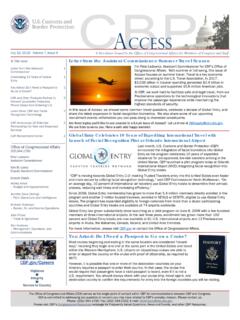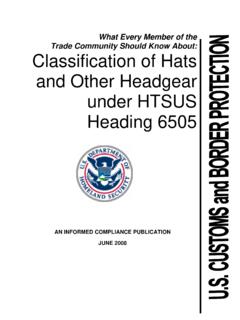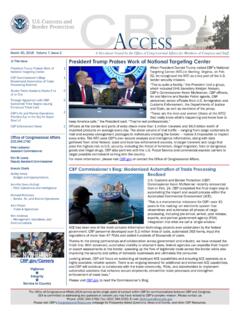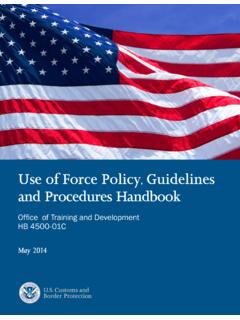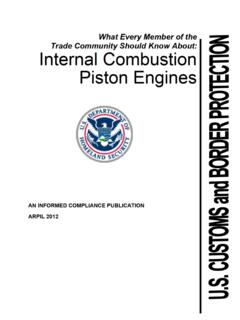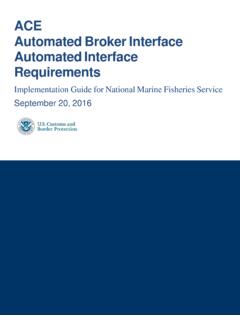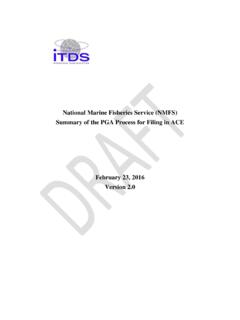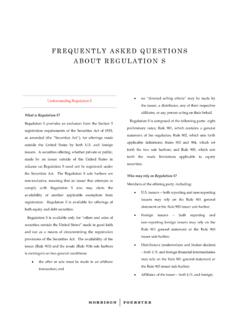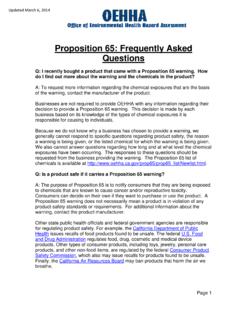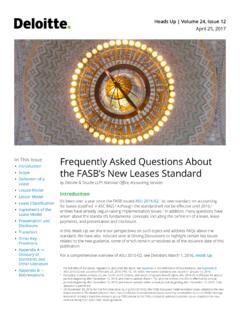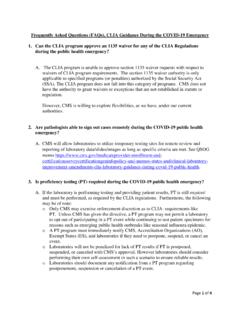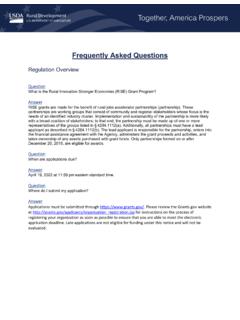Transcription of Frequently Asked Questions on Wood Packaging Materials
1 Frequently Asked Questions on Wood Packaging Materials On September 16, 2005, the United States, in cooperation with Mexico and Canada, began enforcement of international phytosanitary standards for regulated wood Packaging material (WPM) entering North America. On February 1, 2006, this enforcement moved to Phase II, with enforced compliance of the regulation requiring exportation of non-compliant WPM. Full enforcement, Phase III, began July 5, 2006. Enforcement of the international standard will be conducted in accordance with Customs and Border Protection operational guidelines and procedures. On March 9, 2007, a liquidated damages and penalties provision on issues related to WPM went into effect. On November 1, 2017 updates to the penalties provision went into effect. 1. What is the effective date for liquidated damages and penalties under the guidelines?
2 A: The guidelines will only be applied to shipments that arrive on or after the effective date of March 9, 2007. Shipments that arrived before March 8, 2007, will not be subject to the new guidelines. When determining whether a party is subject to penalties based on their prior record for failure to comply with WPM regulations , CBP will only consider an Emergency Action Notification (EAN) received by the party for shipments that arrived on or after March 9, 2007. Effective November 1, 2017, responsible parties with documented WPM violation may be issued a penalty. This is a change from the previous published tolerance of five WPM violations. 2. Why is CBP now issuing liquidated damages and penalties for WPM violations? A: The regulations on WPM set forth in the Code of Federal regulations are intended to protect agricultural resources from the introduction of potentially injurious wood-boring pests.
3 Failure to comply with these regulations poses significant pest risks to agriculture. This policy provides the means to assess liquidated damages against those who do not comply with the action specified on the EAN for failure to comply with WPM regulations . The policy also enables CBP to penalize those documented importers, carriers, or bonded custodians who attempt to enter violative WPM or who attempt to conceal a WPM violation. 3. When will an EAN be issued? A: An EAN will be issued when a WPM violation is discovered. A WPM violation occurs when WPM entering the does not adhere to the required treatment under the Guidelines for Regulating Wood Packaging material in International Trade of the International Standards of Phytosanitary Measures (ISPM-15); the WPM regulations ; and any associated amendments, revisions or exemptions identified by the Department of Agriculture, Animal and Plant Health Inspection Service.
4 4. Who will receive an EAN for failure to comply with WPM regulations ? A: The party that is responsible for the WPM ( , the party whose bond was obligated) at the time that the violation is discovered will receive an EAN. Frequently Asked Questions on Wood Packaging Materials 5. How long will the violator be given to comply with the EAN for failure to comply with WPM regulation? A: The time frame in which the action must be completed will be specified in Block 17 of the EAN. CBP will use its discretionary authority to determine a reasonable time for completion of the specified action. 6. What happens when violative WPM is found with in-transit or in-bond containers or cargo? A: Shipments that arrive in the , enter the under a bond, or are in-transit through the from foreign countries must meet all conditions of the bond and adhere to all rules and regulations set forth under laws and regulations .
5 If an in-bond shipment is found to contain violative WPM, then the party who is responsible for the merchandise under a bond will be issued an EAN. Upon receipt of the EAN, it is expected that expeditious action shall be taken to comply with the terms and conditions of the notification. In the event that the recipient is non-compliant with the EAN and there is a failure to export the WPM, then liquidated damages will be assessed. 7. When will liquidated damages be assessed? A: Liquidated damages will be assessed when a party fails to comply with the terms of an EAN. Therefore, liquidated damages claims shall not be assessed for the mere importation of violative WPM, but will be assessed for non-compliance with the EAN issued as a result of the importation of violative WPM. 8. Who will be subject to a liquidated damages claim for failure to comply with WPM regulation?
6 A: The party that received the EAN and failed to comply with the terms of the EAN will be subject to a liquidated damages claim. In the event that a party receives an EAN, but was not responsible for the shipment (their bond was not obligated), it will not be subject to liquidated damages. 9. When will penalties be assessed? A: Penalties may be assessed when a party attempts to conceal a WPM violation or a party has failed to comply with 7 CFR Penalties for failure to comply with 7 CFR may be assessed even if the party has complied with past EANs and/or has complied with the EAN that resulted in the penalty. 10. Is WPM that remains onboard a vessel subject to potential liquidated damages and penalties? A: Unmarked WPM that remains onboard a vessel (seagoing carrier) is not in violation of the ISPM-15 markings standard. However, if the WPM is unloaded and found violative, then the vessel owner or carrier shall be issued an EAN if it is still responsible for the shipment at the time the violation is discovered.
7 If the recipient does not comply with the terms and conditions of the EAN, it shall be subject to liquidated damages. A penalty may also be assessed for the violative WPM. Frequently Asked Questions on Wood Packaging Materials 11. What is the reason for the WPM regulation? A: Untreated wood poses a significant risk of introducing plant pests, including pathogens, that can be detrimental to agriculture and to natural, cultivated, and urban forest resources. Department of Agriculture regulations contain provisions to mitigate plant pest risk presented by the importation of such wood. Because the Packaging Materials are very often reused, the true origin of any piece of WPM is difficult to determine and, thus, its treatment status cannot be ascertained. Therefore, the USDA amended its regulations to decrease the risk of WPM introducing plant pests into the by adopting the international standard for WPM approved by the Interim Commission on Phytosanitary Measures of the International Plant Protection Convention (IPPC) on March 15, 2002.
8 By adopting the IPPC guidelines, the is harmonizing its trade requirements with a host of other countries that have also adopted the guidelines and have, or are preparing to, implement the requirements. 12. What kinds of WPM are covered by this regulation? A: Most wood Packaging Materials are covered by the new rule, including wooden Packaging Materials such as pallets, crates, boxes, and pieces of wood used to support or brace cargo. The regulations formerly referred to these types of Materials as solid wood packing material (SWPM). Wood Packaging material is defined as wood or wood products (excluding paper products) used for supporting, protecting, or carrying cargo, including, but not limited to, dunnage, crating, pallets, packing blocks, drums, cases, or skids. The definition excludes manufactured wood Materials , loose wood packing Materials , and wood pieces less than 6mm thick in any dimension.
9 13. What are the actual treatment and marking requirements? A: There are two treatment options: heat treatment or fumigation with methyl bromide. For heat treatment, WPM must be heat treated to achieve a minimum wood core temperature of 56 C for a minimum of 30 minutes. For fumigation, the WPM must be fumigated with methyl bromide in an enclosed area for at least 16 hours at the regulated dosage and then must be aerated to reduce the concentration of fumigant below hazardous exposure levels. After either of these treatments, the WPM must be marked in a visible location on each article, preferably on at least two opposite sides of the article, with a legible and permanent mark, approved by the IPPC, to certify that wood Packaging material has been subjected to an approved treatment. 14. What does the approved mark look like? A: Marks will vary by country and treatment establishment.
10 The ISPM-15, Annex 2 ( ) describes the mark and its application. It also gives examples of acceptable variants to the mark. The basic design and acceptable variants to the design are shown below. The mark must include the IPPC trademarked graphic symbol, the ISO two-letter country code for the country that produced the wood Packaging material , a unique number assigned by the national plant protection agency of that country to the producer of the wood Packaging material , and an abbreviation disclosing the type of treatment. Frequently Asked Questions on Wood Packaging Materials Figure 1. Basic design of marking. Figure 2. Right-side elements stacked. Figure 3. Right-side elements in single line. Box with rounded corners, which may be found with the other arrangements of the elements. Figure 4. Stenciled design. Usually inferred by the gaps on the box border and other elements.
